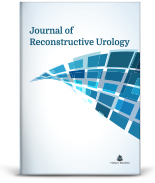Objective: Uroflowmetry is one of the most commonly used assessment tools in patients with lower urinary tract symptoms (LUTS). However, uroflowmetric parameters can be affected by various factors. In this study, we aimed to examine the effects of different voiding positions on uroflowmeter parameters. Material and Methods: 105 patients aged 40-80 years who applied to the urology outpatient clinic with the complaint of LUTS were included in the Our Prospective study. Uroflowmetry measurements were performed on each of the participants in standing and sitting positions, one day apart. After uroflowmetry, residual urine was measured by transabdominal ultrasound in each patient. Qmax, Qave, voiding volume, voiding time and residual urine volumes of the patients in standing and sitting positions were compared. Results: The mean Qmax-Qave-voiding volume values of the patients were measured as 13. 8 mL/s-7 mL/s-336 mL in the sitting position and 11. 6 mL/s-6 mL/s-304 mL in the standing position respectivly. Qmax, Qave values and voiding volume values were significantly higher in patients who voided in the sitting position (p<0.001). The residual urine amount of the patients after voiding was measured as 20 mL in the sitting position and 40 mL in the standing position, and it was observed that the amount of residual urine in the patients who voided while sitting position was significantly less (p<0.001). Conclusion: In our study, it was observed that voiding position had an effect on uroflowmetry parameters. Urinating, especially in a sitting position, has a positive effect on uroflowmetry parameters.
Keywords: Üroflowmetry; sitting position; standing position; lower urinary tract symptoms
Amaç: Üroflowmetri alt üriner sistem semptomlu (AÜSS) hastalarda en sık kullanılan değerlendirme araçlarından biridir. Ancak üroflowmetrik parametreler çeşitli faktörlerden etkilenebilir. Bu çalışmada farklı işeme pozisyonlarının üroflowmetre parametreleri üzerine etkilerini incelemeyi amaçladık. Gereç ve Yöntemler: Prospektif çalışmamıza AÜSS şikâyeti ile üroloji polikliniğine başvuran 40-80 yaş arası 105 hasta dâhil edildi. Üroflowmetri ölçümleri her katılımcıya bir gün arayla ayakta ve oturur pozisyonda yapıldı. Üroflowmetri sonrasında her hastada trans abdominal ultrason ile rezidüel idrar ölçüldü. Hastaların ayakta ve oturur pozisyondaki Qmaks, Qort, işeme hacmi, işeme süresi ve rezidüel idrar hacimleri karşılaştırıldı. Bulgular: Hastaların ortalama Qmaks-Qort, işeme hacmi değerleri, sırasıyla oturur pozisyonda 13,8 mL/s-7 mL/s-336 mL, ayakta ise 11,6 mL/s-6 mL/s-304 mL olarak ölçüldü. Oturma pozisyonunda işeyen hastalarda Qmaks, Qort değerleri ve işeme hacmi değerleri anlamlı olarak yüksekti (p<0,001). Hastaların işeme sonrası kalan idrar miktarı oturur pozisyonda 20 mL, ayakta 40 mL olarak ölçüldü ve oturur pozisyonda işeyen hastalarda kalan idrar miktarının anlamlı derecede daha az olduğu görüldü (p<0,001). Sonuç: Çalışmamızda işeme pozisyonunun üroflowmetri parametreleri üzerinde etkili olduğu görüldü. Özellikle oturur pozisyonda idrar yapmak üroflowmetri parametreleri üzerinde olumlu etki sağlamaktadır.
Anahtar Kelimeler: Üroflowmetri; oturma pozisyonu; ayakta pozisyon; alt üriner sistem semptomları
- Grino PB, Bruskewitz R, Blaivas JG, Siroky MB, Andersen JT, Cook T, et al. Maximum urinary flow rate by uroflowmetry: automatic or visual interpretation. J Urol. 1993;149(2):339-41. [Crossref] [PubMed]
- Goel A, Kanodia G, Sokhal AK, Singh K, Agrawal M, Sankhwar S. Evaluation of impact of voiding posture on uroflowmetry parameters in men. World J Mens Health. 2017;35(2):100-6. [Crossref] [PubMed] [PMC]
- Norg R, Portegijs P, van Schayck CP, Van de Beek C, Knottnerus JA. Please be seated? Positionrelated differences in voiding in men with lower urinary tract symptoms: A general practitioner's approach to lower urinary tract symptoms. Maastricht: Maastricht University. 2008. p.55-69. (Access date: 05.23.2024) [Crossref]
- Salem T, Abbas H, Ali M, Al Robigi A. The effect of voiding position on uroflowmetry findings and postvoiding residual urine in patients with benign prostatic hyperplasia. Urol Today Int J. 2009;2(3):5-7. [Crossref]
- de Jong Y, Pinckaers JH, ten Brinck RM, Lycklama à Nijeholt AA, Dekkers OM. Urinating standing versus sitting: position is of influence in men with prostate enlargement. A systematic review and meta-analysis. PLoS One. 2014;9(7):e101320. [Crossref] [PubMed] [PMC]
- Unsal A, Cimentepe E. Effect of voiding position on uroflowmetric parameters and post-void residual urine volume in patients with benign prostatic hyperplasia. Scand J Urol Nephrol. 2004;38(3):240-2. [Crossref] [PubMed]
- Witjes WP, Wijkstra H, Debruyne FM, de la Rosette JJ. Quantitative assessment of uroflow: is there a circadian rhythm? Urology. 1997;50(2):221-8. [Crossref] [PubMed]
- Yazici CM, Turker P, Dogan C. Effect of voiding position on uroflowmetric parameters in healthy and obstructed male patients. Urol J. 2014;10(4):1106-13. [PubMed]
- Unsal A, Cimentepe E. Voiding position does not affect uroflowmetric parameters and post-void residual urine volume in healthy volunteers. Scand J Urol Nephrol. 2004;38(6):469-71. [Crossref] [PubMed]
- Aghamir SM, Mohseni M, Arasteh S. The effect of voiding position on uroflowmetry findings of healthy men and patients with benign prostatic hyperplasia. Urol J. 2005;2(4):216-21. [PubMed]
- Eryıldırım B, Tarhan F, Kuyumcuoğlu U, Erbay E, Pembegül N. Position-related changes in uroflowmetric parameters in healthy young men. Neurourol Urodyn. 2006;25(3):249-51. [Crossref] [PubMed]
- Haylen BT, Ashby D, Sutherst JR, Frazer MI, West CR. Maximum and average urine flow rates in normal male and female populations--the Liverpool nomograms. Br J Urol. 1989;64(1):30-8. [Crossref] [PubMed]
- Zhang C, Zhang Y, Cruz Y, Boone TB, Munoz A. Synergistic activities of abdominal muscles are required for efficient micturition in anesthetized female mice. Int Neurourol J. 2018;22(1):9-19. [Crossref] [PubMed] [PMC]
- Tosun ÖÇ, Dayıcan DK, Keser İ, Kurt S, Yıldırım M, Tosun G. Are clinically recommended pelvic floor muscle relaxation positions really efficient for muscle relaxation? Int Urogynecol J. 2022;33(9):2391-400. [Crossref] [PubMed]







.: Process List